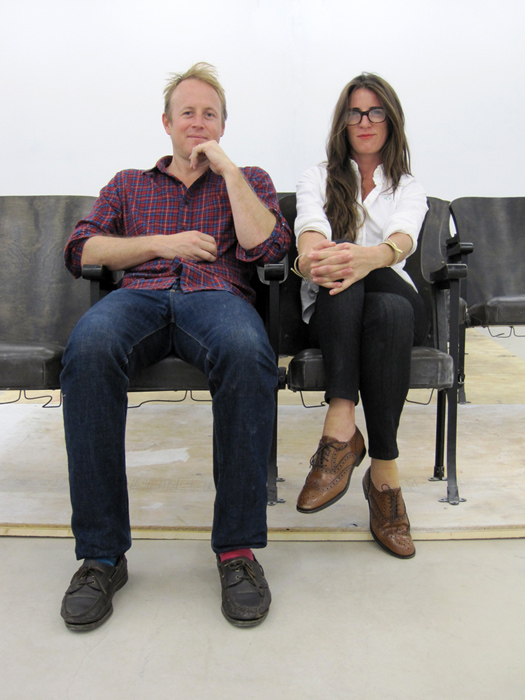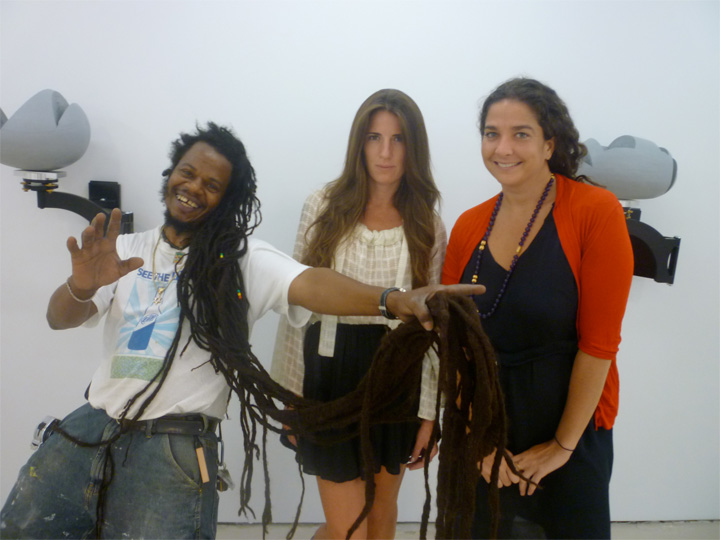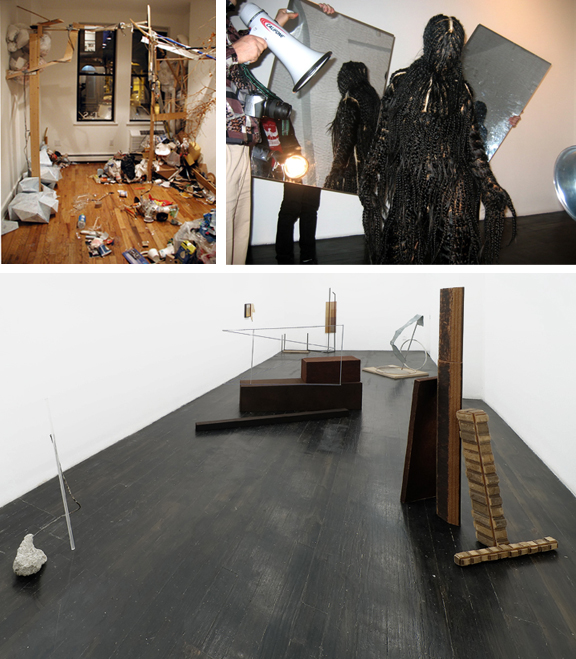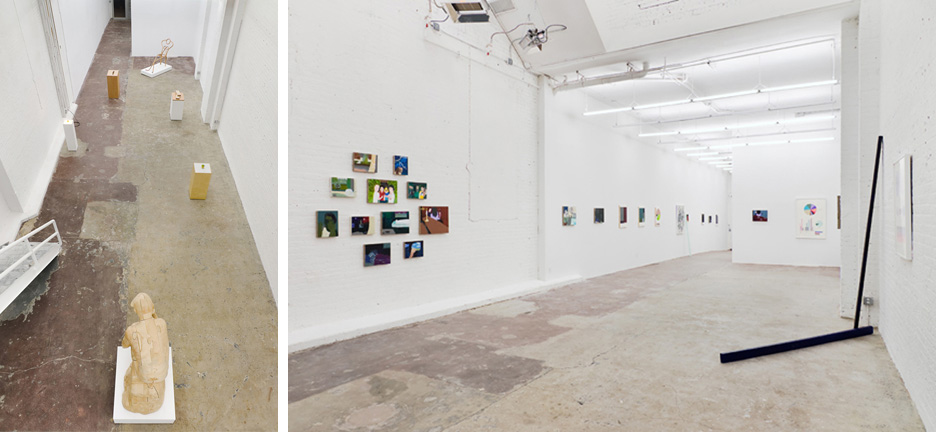
|

|

JOHNNY MISHEFF: Taxter and Spengemann is
one of my favorite galleries in the whole wide world... How long have you guys
been around now?
KELLY TAXTER: We opened in september of
2003. It's September of 2010. That
means we are in our 8th season -
that being from Sept - August. We
are getting old. 3rd
grade. Long division. Books without
pictures. Picking teams in gym class. Crushes,
etc.
JM: HA! Well do
you have any crushes you'd like to
make public here???
KT: We have wandering eyes,
always. But do not kiss and tell.
JM: What was the impetus to
start this thing? What's your history with Pascal?
KT: Pascal and I were at the
Center for Curatorial Studies at Bard College together. I was a year ahead of
him - though he's
older than me! - anyway, we had a class at DIA every Thursday and we'd have
lunch and talk about how we interpreted the idea of curating, what we liked and
disliked about the profession and its codes of conduct, and that turned into
driving around in his Honda after class, before heading back upstate, calling
for lease signs in windows, dumbly poking about downtown to see what the odds
were that we could rent a space of our own. To be honest we thought very little
about the practicalities of running a business but we had a natural rapport and
a similarly tenored sense of ambition.
We had a lot of friends who were artists and figured we could all work
together if given a place to do it.

|
| PASCAL SPENGEMANN AND KELLY TAXTER. |
JM: And now you are three. Can you speak to this fresh perspective/energy Carolyn
Ramo brings to
the table?
KT: We've known Carolyn for
years… she was the director at Nicole Klagsbrun and most recently at David Zwirner
managing production for artist’s works and projects. We were at a party
last summer… outside… many drinks… hot… and started talking about how it would
be nice to have a third brain, someone who could help us focus our energies and
see us through to another stage of our development which we felt a lot of
pressure to get to. Carolyn brings a lot of business acumen, hustle, and
practical know-how to our sometimes drift-y ideas. Anyway, she voiced that she was antsy and eager to do
something independent and so over the course of this past year we figured out
how to bring her into the fold.

|
| KELLY TAXTER AND CAROLYN RAMO, JOINED BY ONE OF THE MOST ENTERTAINING CONTRACTORS AROUND. |
JM: You've just moved to a new space. This is the 3rd space you've
occupied in the last 8 seasons. Can you talk about operating in and with all these various spaces, and the way you have
been able to work (or not) with them? KT: That’s a big question! Let's start with
the townhouse on 22nd street. I loved it, but it was small. It presented itself as very intimate
which 50% of the time was great for the artwork and 50% of the time constricting. I think it was a beautiful and comfortable
space and because it was so different from our neighbors on that block it allowed people who whipped around Chelsea to remember
the shows they saw there, of artists they may have not heard of or seen before, largely in part because the architecture defined
itself against the flow of white box, cement floor, etc buildings, that they also went into that day for 5 minutes. The
downsides were that it was quaint, and that's not always something that we - or the artists - wanted to contend with. White
box spaces are predominant for a reason - I could make a few other arguments about them also - but let's just cut it short
and say we started to want something bigger and less residential in attitude and so did the artists who had already mounted
a few shows at 504 W 22nd.
| THE WEST 22ND STREET YEARS: |

|
| CHARLOTTE BECKET INSTALL VIEW. ANDREW STRASSER W XAVER CHA AS CORNROW. MACRAE SEMANS INSTALL VIEW. |
KT (CONTINUED): So we left… and went to
the polar opposite neighborhood and building. 123 E 12th Street... so
completely amazing in theory, so tricky in practice. 12th street was our
first radical shift and the first time we took on any kind of project on that
scale. That space was so massive
and inspiring and gorgeous and a mess and a beast - like a wild animal. The
shows we had there were alternately perfect for it and swallowed by it… I think
for the whole gallery it was a challenge in many unexpected ways. As for
the neighborhood, I loved working on the east side so much, and it is much
easier to get to than west Chelsea, but our collectors and most people that go
to galleries on a regular basis had a hard time looping it into their schedules
because it was neither LES nor Chelsea. We ended up getting lonely sometimes. So we left there too.
I moved 9 times when I was a child so,
I'm used to bouncing around. Change is good, or something like that....
| THE 12TH STREET YEAR: |

|
| MATT JOHNSON INSTALL VIEW (LEFT). ANDREW KUO INSTALL VIEW (RIGHT). |
KT (CONTINUED): 459 W 18th Street is as
normal as it gets for us. The space is part of a new construction condo -
so we started off with a very bland prospect, so we had an artist, Ara Dymond,
design the spaces, the lighting, and our offices. Having a person who is primarily a sculptor with an
aesthetically trained eye take the reigns has been incredible for us. I'm
very excited to have a neat and clean space with heat and air conditioning and
two SQUARE exhibition rooms instead of rectangles and I'm really happy to be
back in a neighborhood that we are meant to be in and where I'll see all of the
people I missed last year and that missed us.
JM: What is your favorite
type of work versus the sort of work that typically sells the best for you?
KT: My initial steps into
curating were taken with the idea that I would focus on video and sound and
performance - its what I liked. I
grew up playing and composing music and later films and I naturally turned my
attention towards that kind of art making. Some of the most challenging
ideas about art are obviously presented through less traditional formats, but
it almost feels ridiculous to say that performance, for example, is non-traditional
at this point. I think Xavier Cha,
who’s had two shows with us, has one of the best minds. Her approach to
her work, rooted in performance, is exceptional. There are no superfluous words, objects, images, movements,
or ideas - every aspect of what she does is thoroughly thought through and
reasoned. The result is bizarre
and confusing; somehow everything opens
up in my mind.
But you know, I also eat
small jewel-like paintings up as quickly and greedily as the next guy. I never
tire of an exquisite object,
ever. There is nothing more
gratifying.
JM: Talk to
me like I don't
know the 1st thing about selling performance art. What
are the challenges of selling performance art versus those small jewel-like
paintings?
KT: I
think it’s largely up
to the artist - how does he or she want to or need to translate the idea they
have into some kind of commodity? In the case of Holiday Cruise, a piece by Xavier Cha, she
sold her "costumes.” I put costumes in quotes, as they are
sculptures that are then inhabited by the artist and used as part of the
performance. The Hammer Museum in
LA has all three "costumes" now and if they are to exhibit them they
must also activate them. The
artist has to come out to the museum and make the performance happen. I’m
realizing as I tell you this that it’s not easy to describe this kind of thing
to someone with no context, as you suggested. Anyway… performance artists generally incorporate a few
different elements into their work whether those are objects, or actors and I
think as a result of bringing a few things together you can then figure out a
way to "sell" a piece that on the surface of things, doesn't appear
to be commercially viable.
JM: Can
you speak to the
relationship between yourself and the artists you represent?
KT: Relationships....!
Some are more familial than others
and some are pretty distanced. It
totally depends on what the artist wants from me, or what I sense they might
need at any given time. A lot of the artists we show were our friends
first, but as things have evolved and people have had more and more shows and
etc, I've had to re-focus my energy. Things got serious in the last few years; stakes got higher;
I no longer go out or see the sun - I am glued to my computer and super
agent-ing all over the world. I'm
pale and thin. My dog is my life
partner.
JM: Hahaha,
Maisy is an
incredible life partner for SURE. So is it all worth it? Would you
ever give it up if it got to be way too crazy?? KT: To be
perfectly honest,
it’s already gotten too crazy. Moving
twice within a year and a half has been life altering. I don't think
anything that is worth devoting one’s life to is easy. When I was younger I assumed that as I
grew up, life would be smooth sailing. What an idiot.
JM: Where
do you see T&S
in ten years?
KT: Like
DIA......but better.
|

|

|

